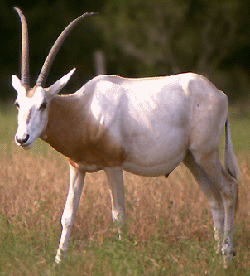|
Exotics: Oryx and Gemsbok Cartridges By Chuck Hawks The scimitar oryx (Oryx dammah) is a species of antelope that formerly inhabited the whole of North Africa. Today it may be extinct in the wild. Fortunately, and thanks to game ranches and hunting preserves, huntable numbers of these animals exist on private land. A full grown scimitar oryx is over a yard tall at the shoulder and on average weighs about 440 pounds. It is mostly white with a brown chest and (often) black markings on the forehead and down the length of the nose.  Both males and females have horns. These horns are long, thin, parallel and curve backwards. They can reach a length of up to 40" or more in either sex. The gemsbok (Oryx gazella) is another large African antelope of the genus Oryx. It lives in southeast Africa. In the wild the gemsbok is a desert animal, but it has adapted and prospered on game ranches, particularly in Texas. Gemsbok were imported into New Mexico starting in 1969 and free roaming herds now exist in huntable numbers there. Gemsbok are similar in size to the scimitar oryx, with an average mature shoulder height of about four feet. They can weigh up to 450 pounds on the hoof. Gemsbok have tan bodies with black and white legs and faces and a black stripe running down the underside of the neck.  Both males and females wear long, gently curved horns, but the male's are thicker. These horns are serious weapons that are used to fight off predators. Because of their long, sharp horns and their predilection to use them for close-in defense it is wise not to approach a downed animal until you are sure that it is dead. Scimitar oryx and gemsbok are good sized animals. They are similar to exotic European red stag and not far from Rocky Mountain elk in size, so the calibers that are recommended for those animals should also be a reasonable choice for hunting oryx and gemsbok. As a general rule, figure on using a bullet carrying 1200 ft. lbs. of energy at impact as a minimum. Bullet placement is always more important than kinetic energy, but that 1200 ft. lb. figure will serve as an approximate guide to the maximum range at which a given load should be used. Please bear in mind that in all cases and for all calibers I am assuming that the hunter uses a bullet of adequate weight, sectional density (around .250 or better for all oryx species) and expansion characteristics for the cartridge recommended. Bullets along the lines of the Barnes TSX, Hornady InterLock, Nosler Partition, Remington Core-Lokt, Speer Grand Slam and Winchester Silvertip are appropriate. I am also assuming that the hunter gets that bullet into a vital spot, usually the animal's heart/lung area. As always, it would be too cumbersome to list every adequate cartridge and I would inadvertently leave out someone's favorite in any case. So consider the cartridges mentioned below merely as examples of satisfactory oryx / gemsbok cartridges. If a cartridge is not listed it does not mean it is not appropriate. Look for a cartridge with similar ballistics. If you find one, then the cartridge in question is also probably adequate. Here are some suggested scimitar oryx and gemsbok cartridges: 6.5mm Remington Magnum, 6.5x68, .264 Winchester Magnum, .270 Winchester, the .270 Magnums, 7x57, 7mm-08 Remington, 7x64 Brenneke, .280 Remington, the 7mm Magnums, .308 Marlin, .300 Savage, .308 Winchester, .30-06 Springfield, the .300 Magnums, .303 British, 8x57JS, .338 Federal, .338-06 A-Square, .338 Win. Magnum, .356 Winchester, .358 Winchester, .35 Whelen, .350 Remington Magnum, 9.3x57, 9.3x62, 9.3x74, .375 Winchester, .405 Winchester, .444 Marlin and similar cartridges. Fortunately, long range shooting is seldom required on hunting preserves. Stay within the maximum point blank range (+/- 3") and 1200 ft. lbs. of kinetic energy on target limitation of whatever cartridge you select, get a proper bullet into a vital spot, and you should have the oryx or gemsbok trophy of your dreams. |